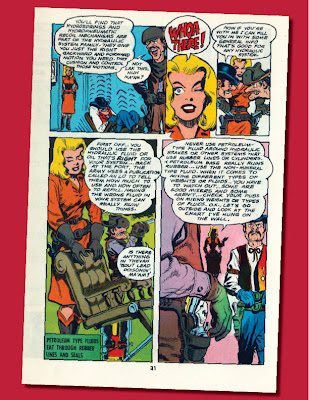When the world was made aware of the June 3 death of actor James Arness, at the age of 88, I had a flashback to a sun-filled, early autumn evening in 1960, sitting beside Will Eisner aboard one of the early commercial jets, on our way to San Francisco and, ultimately, Korea.

We had looked down at Manhattan when the jet circled westward and talked about Will’s abiding affection for the Big Apple, with its (then) grime and hard shell. When that conversation lagged, I had asked him which PS episodes, if any, he had really enjoyed producing. The first one that he mentioned was Gunsmoke.

At the time of that conversation, PS 93 had just come off the presses. TheGunsmoke issue, PS 81, had been a year before, in August of 1959. The television version of the adventures of U.S. Marshal Matt Dillon premiered in 1955, and the PS tip-of-the-hat appeared during the show’s fourth year of its eventual 20-year run.

Eisner said that he had been a nominal fan of William Conrad’s radio version of the Dodge City drama but ratcheted his enthusiasm up a Stetson-full of notches with the visual aspects and dialogue touches that developed with the ensemble troupe that coalesced around Arness as the central character. “Arness’s ‘Matt Dillon’ speaks in sequential-panel balloons,” Will said.

Another facet of Eisner’s enjoyment in doing the PS 81 Gunsmoke thing derived from the manner in which PS Editor James R. Kidd restrained his staff from crowding the artist during its development. The project developed from a discussion during the late stages of a pencil-dummy review conference in the late spring of 1959 in the PS offices at Raritan Arsenal in Metuchen, New Jersey—about half-way between the program’s 1955 transfer out of Aberdeen Proving Ground, in Maryland, and its next move to Fort Knox, Kentucky, in 1952.

The idea developed from a rather spontaneous exchange, but rapidly deteriorated when a couple of aggressive staffers began to pepper Eisner with specific visual notions and demands. Without restraint, they would have been more than willing to tell him how to allocate a page—plus, write the balloons before the art. Kidd dialed things down, told them to back off, and later channeled them into the task of preparing a script of technical necessities regarding the general field of hydraulics, and preventive maintenance of hydraulic equipment. Far-fetched? Not when a mal-functioning barber-chair played a key role at a critical moment in the PS-notion of a Gunsmoke dramatic episode!

Eisner’s concept for the Front Cover beautifully invoked the classic Gunsmoke opening-shot.
At one point when Joe Kubert and I were at Redstone Arsenal recently for the official U. S. Army celebration of the PS Magazine Sixtieth Anniversary, we found ourselves in the neighborhood of a giant blow-up of that cover. I was engaged in a conversation with several people, but I could hear Joe, behind me, delivering to another small group a precise analysis of what Eisner had done—and why. I hope he will append those remarks to this blogpost.

For me, the Gunsmoke Front Cover and Continuity of PS 81 present a precisely perfect melding of an essential technical message with the communication potential of imaginative sequential art.
—p.e.f.
[The cover for] PS 81 is a perfect example of the cartoonist's use of composition and color to tell his story clearly with impact. A complex illustration that Will simplified by the use of orange and red, except for the foreground gunbelt and gunbutt and the background figure—where contrasting blues and whites were applied. In this way, Will accomplished two things: he created an additional depth to the illustration and caused the reader/viewer to focus on the cover's point. The gun in the holster (handle falling apart because of lack of maintenance) and the spider-web connected to the handle (again showing lack of current maintenance). It is abundantly clear that the man in the background is about to do away with the foreground character for those obvious reasons.
The cover also contains a building, horses tied to a hitching post, a deep background with two men running, a couple of guys peeking out of the saloon door and two more guys hiding under the porch and one more behind the horses. With all this stuff to flesh out an interesting drawing, Will knew that the main point should be noticed first, and that's the way he designed the cover. Good compositions and proper graphic communication is no accident. Like Will always said, "The best cartoonist is the thinking cartoonist
—j.k.

UPCOMING POSTINGS:
¶ A Covey of Connies: World War II to Today
¶ Best of Zeke Zekely in PS
¶ PS Characters in Animation
¶ Early Covers Put Eisner, PS in Hot Water









No comments:
Post a Comment